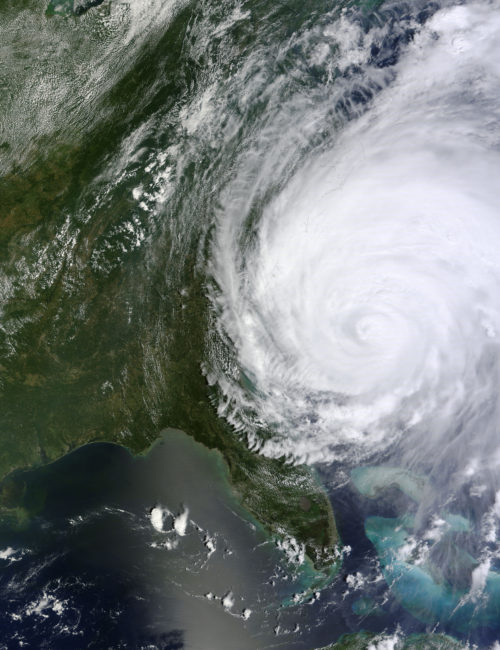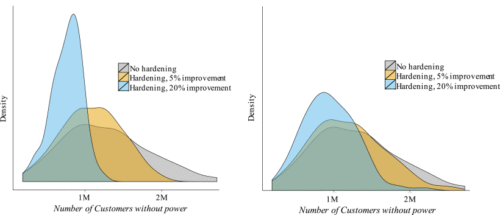The Die of the Storm
Kate Petersen ·Dice clatter on a plain table in a quiet room. The truncated, cacophonous collision of plastic and faux wood laminate foretells the destiny of a densely populated urban area. The game master considers the exposed numbers reflected in the light of a computer screen before inputting the next fated event: Power station 3, grid section 6 fails. Pump 617 offline. Floodwaters overtop levees 6, 7, and 31. Public infrastructure workers watch helplessly as turbid water rushes through the streets of residential area 63, submerging cars, destroying homes, and inundating septic systems. This is a complete disaster but, fortunately, in this case, a simulated one. A simulation that Dr. Allison Coffey Reilly and colleagues at the University of Maryland Center for Disaster Resilience believe will help improve disaster response and public utility infrastructure resilience to hurricanes and other extreme weather events.

After a major hurricane or flood, populations can be left without electricity and other services for days and weeks. This is, at best, an inconvenience, but can often and quickly become a significant and threatening disruption when people rely on electricity to power medical equipment or heat their homes. Additionally, electricity is used to power other public safety infrastructure such as water pumps that remove excess rainwater to prevent flooding. Already a public safety problem, destructive storm events are likely to increase in magnitude and otherwise deviate from established historical patterns due to global climate change. On one level, the ramifications of these events will be driven by wind speed, rainfall, and other consequences of atmospheric physics. On another level, outcomes are driven by human behavior both before and after storm events.
This is where Dr. Reilly’s research makes landfall; she investigates the ways human behavior and responses in disaster events affect infrastructure resiliency and recovery. For instance, past researchers have identified a tendency of homebuyers, following major flooding events, to purchase houses near newly constructed levees because they believe that they will be safest there. Instead, they are again threatened when a larger than anticipated flood overtops the levee. Dr. Reilly used this particular example to emphasize the importance of understanding disaster outcomes in the context of an area’s history of disasters. “There really is this interplay between how people and infrastructure behave in disasters,” Dr. Reilly explains. Disasters don’t tend to happen in isolation (particularly in a global climate change scenario). Human behavior following the last disaster, whether it be that of consumers, public policy makers, or utility companies, will affect outcomes in the next disaster.

While predicting the responses of individual humans following a disaster may be impossible, Dr. Reilly’s team focuses on uncovering broader patterns of behavior associated with a range of probabilistic outcomes, an endeavor that demands creative and multidisciplinary research strategies. Dr. Reilly and colleagues have found gaming techniques to be helpful tools for developing probability-driven models of human behavior. They invite utility workers to participate in computer simulated disaster scenarios where dice rolls can be used to determine the success of their interventions and the nature of the next challenge they face. The game allows researchers to study human behavior in real time, and in many different scenarios, without the help of an actual Category 3 hurricane. “Ultimately, what we’d like to see is whether more coordination and communication about key assets will speed recovery,” said Dr. Reilly.
Agent-based modeling is another way Dr. Reilly accommodates all the players at the table. These models incorporate interactions between agents (people) and between agents and their environment. Dr. Reilly used this method to uncover a surprising relationship between consumer behavior after a hazard-induced power outage and the likelihood of future power outages.

Following a major power outage, it is not uncommon (or unreasonable) for consumers to purchase a portable generator to prevent future power outages from being so disruptive. This is called an individual action, one where a consumer takes private action to mitigate future harm. However, Dr. Reilly’s team suspected that an individual action could reduce the probability of collective action, in this case, a critical mass of complaints that would pressure the power company to invest in fortifying infrastructure. This model is described in simple terms here, but it had to accommodate a wide range of variables including: consumer belief that future power outages were a threat, number of complaints required to induce utility company response, the degree of infrastructure improvement required to avoid blackouts, the economic demographics of consumers, and the history of area power failures.

Dr. Reilly’s team found that increases in generator purchases did negatively impact power availability over the studied time frame, but only if the utility company invested in significant grid improvements after a blackout. The relationship between consumer behavior and power loss events was not pronounced when the utility made minimal improvements. This counterintuitive result is thought to be because minimal improvements did not reduce blackouts enough over time to restore consumer faith in their utility company. This led to those with economic means buying generators instead of filing complaints. When the utility makes significant improvements after a blackout and widespread blackouts became less common, consumers expect more from the utility company and file complaints instead of buying generators. This pressures the utility company to make further improvements, reducing blackouts for everyone, not just those able to buy generators.
Dr. Reilly’s work, by illuminating previously clandestine inter-relationships, will allow society to make more sophisticated and informed decisions as we are challenged by increasing climatic uncertainty. While we cannot unmake the dire circumstances of our time, decision making grounded in methodical trial and error, where complexity is appropriately entertained, is an investment in a world where fate is not solely contingent on the roll of a die.
Next Post > Earthward Bound: Ricky Arnold returns from the International Space Station
Comments
-
Melissa 7 years ago
Thanks, Kate, for covering Dr. Reilly's research! If you're interested in learning more, check out a video on this work at: https://go.umd.edu/dis-rec

